Go to any hardware store - you will gasp from the abundance of electric kettles of all shapes and sizes. But even if you like a certain model outwardly, this does not mean that you need to immediately carry it to the cashier. Perhaps it will be uncomfortable for you. In order not to get lost in the store and even without the help of a consultant to be able to find a good teapot, first familiarize yourself with the recommendations of our experts.
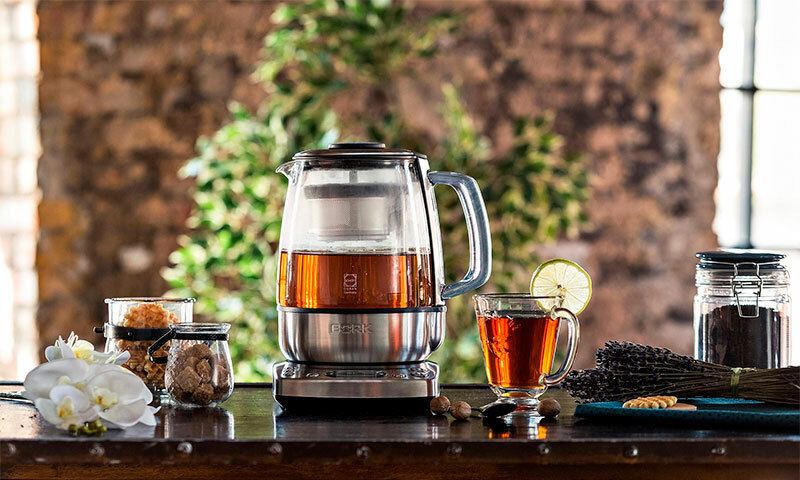
Contents:
- The best companies producing electric kettles
- The principle of operation and the device of an electric kettle
- The types of electric kettles
- The parameters of the choice of electric kettles
- Which electric kettle to choose
- The cost of an electric kettle
The best manufacturers of electric kettles - which company to choose
Of course, it is better to buy household appliances knownmanufacturers. Serious companies not only monitor the quality of their models, but also constantly improve them. The competition in this market is very high, and no one wants to lose confidence in the brand.
The most popular manufacturers of electric kettles today are:
1. Philips
2. Bosch
3. Tefal
4. Redmond
5. Delonghi
You can get acquainted with specific models of these brands in our rating of the best electric kettles. However, the choice of a teapot should not be limited to just the name of the manufacturer. You will have to delve into the design features of this simple technique.
Principle of operation and installation of an electric kettle

Modern electric kettle all come with special supports made of plastic or metal-plastic - they are connected to the outlet through a thick cord with grounding. On the platform, three contacts are output, supplying voltage to the heating element in the tank itself, when you put the kettle on this "heel".
The device itself has a traditional shape or slightly elongated body made of plastic, glass, ceramic or stainless steel. And inside of it the most important detail is hidden - a heating element. To close the circuit and apply voltage to it, just press the button or the lever of the switch of the kettle. Next to it, a bimetallic plate is installed in the casing, which is responsible for automatic shutdown. As soon as the water in the flask is boiling, the contacts will heat up and open, turning off the appliance.
Types of electric kettles
With open spiral
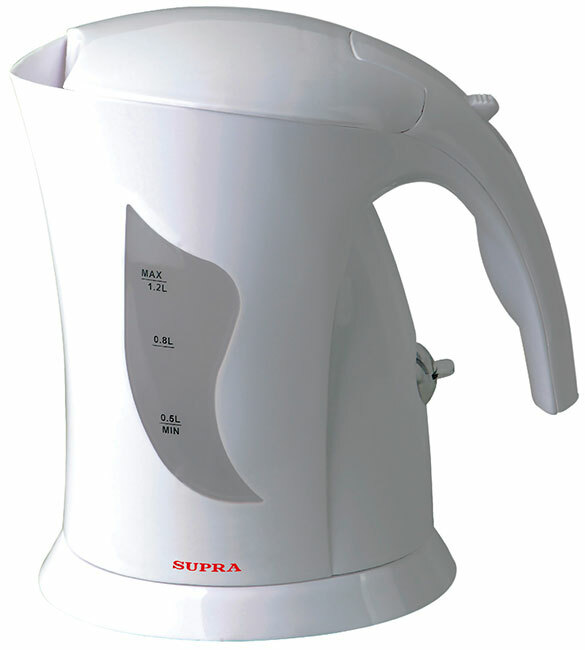
Electric models with an open heating element were among the first such devices. They got their name because the spiral TEN is directly in the flask with water. These kettles are one of the cheapest, but they have a serious drawback. On an open heater, constantly in contact with the liquid, scale is formed very quickly, which is difficult to completely remove.
Pros:
- Low cost;
- Easy to use;
- Rapid boiling of water;
- Cost-effective power consumption;
- Minimum noise.
Cons:
- The need to constantly clean the heater from scale;
- Do not boil a small amount of water - the spiral should completely cover it.
Discs
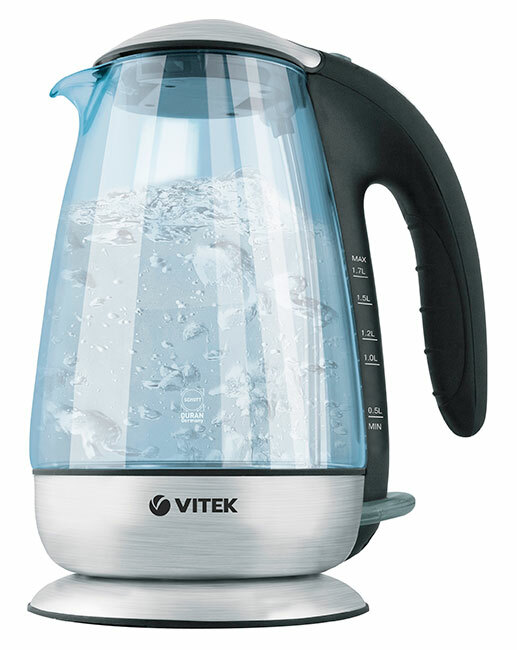
Teapots with a closed heating element have a slightly more complicated design. And although here there is the same spiral TEN, it is no longer in a flask with water, but hides beneath a metal plate and transfers heat directly to it. Thanks to this, the resource of the heating element is significantly increased, and the fight against scale is no longer an actual problem.
Pros:
- Long service life;
- Lower amount of scale;
- Easy to clean thanks to a flat bottom without protruding elements;
- Higher electrical safety.
Cons:
- Cost more expensive than spiral - about 10-20%;
- Shumnovaty.
With
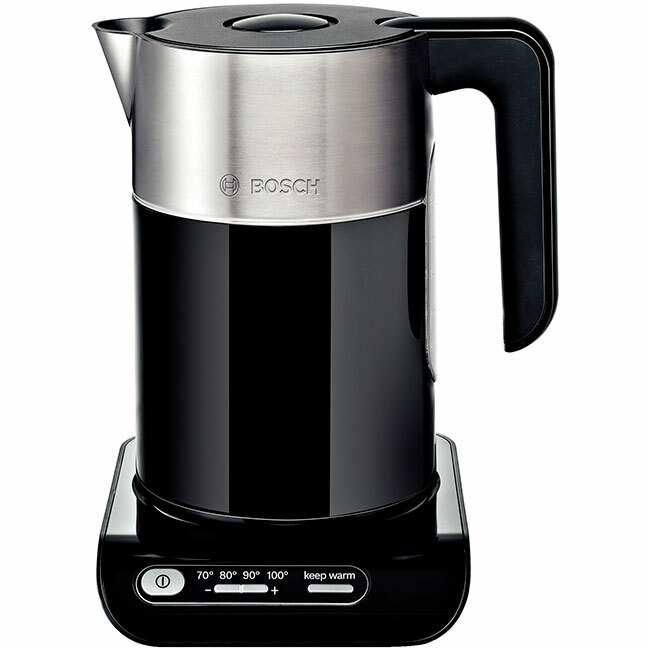
thermostat Unlike conventional models with a single on / off button, such an electric kettle can not only heat water, but also maintain the desired temperature for a set time. Also, there is a possibility of heating below the boiling point( for example, up to +80 or +90 ° C).Teapots with a thermoregulator are ideal for brewing different types of tea, each of which requires a certain temperature of water.
Pros:
- Rapidly heat the water;
- The temperature can be set independently; There is a heating function.
Cons:
- High cost;
- Higher power consumption due to the temperature maintenance mode.
Brewing
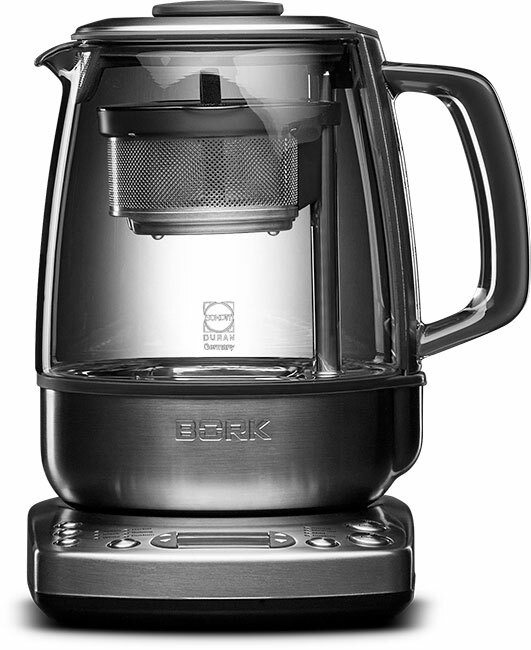
Now there are such electric kettles. They are designed for people who do not represent their life without real leaf tea. Thanks to this device, the process of its preparation takes only up to 5 minutes, and the desired temperature for the selected variety and the time of its maintenance can be set independently.
Advantages:
- Adjustment of the boiling point of water;
- Presence of the timer;
- Simplified but correct preparation of leaf tea.
Cons:
- High power consumption.
Smart teapots
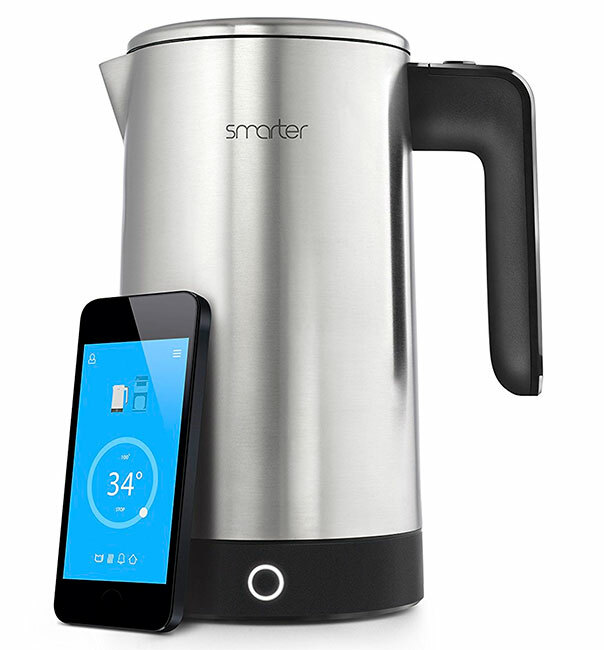
In fact, it's about ordinary electric models that can be controlled via the application on the phone from anywhere in the world. However, the rich functionality is also present here( sound alerts, timer, water temperature adjustment, etc.).Smart kettle is smart in its own way and can do everything - except coffee does not bring you to bed.
Pros:
- You can set any heating temperature;
- Large set of additional functions;
- Ability to control the work of a teapot from a smartphone.
Cons:
- Very expensive;
- High power consumption.
Parameters for the selection of electric kettles

Power and volume
The amount of energy consumed depends on the capacity of the electric kettle. The minimum indicator for such devices is 350 W, the maximum reaches 3 kW.But do not hope that you can deceive fate. The laws of physics are unchanged, and if one needs about 100 Wh to heat 1 liter of water to a boil, that's how much energy the kettle will spend. The only question is how long it will take him. Do not want to wait long - take the model more powerful.
Also, the time of boiling water in the kettle depends on its volume, but this parameter is better to choose according to the composition of the family. Today, manufacturers offer us a choice of equipment from 400 ml to 2.5 liters. Look for a suitable model from the calculation that per person should account for 200-300 ml. And do not forget: the electric kettle can not be poured to the brim - only up to the MAX mark.
When choosing the volume, consider the weight of the device itself( without a platform), because you have to lift it with water. Lightweight plastic model can easily accommodate 2.5 liters, but heavy ceramics of the same capacity to keep on weight will be inconvenient - here is better to show a more compact technique for 1-1.5 liters.
Case material
1. Plastic
The cheapest and lightest material. Teapots made of plastic are easy to clean, have less weight and serve for a long time, although they can not be called eternal. Of the minuses, you can identify possible harm to health if plastic of poor quality( it is easy to recognize by chemical smell when heated) and low resistance to mechanical damage is used.
2. Stainless steel
These teapots are durable, durable and are considered the most reliable. Unlike plastic ones, they cool longer, but their body heats up so much that it is sometimes impossible to touch it. Because of this, today most of these models are equipped with an additional internal plastic bulb. The air layer between the walls protects you from burns, but at the same time it keeps the heat of heated water well.
3. Ceramics
These cozy teapots today conquered many. But they love them not only for their attractive appearance and stylization under the old days. Ceramic electric kettles emit less noise, do not collect scale on the walls and permanently retain the heat of the heated water. However, they require careful handling, because ceramics - the material is brittle and very heavy. The disadvantage of such models is also considered a slow and uneconomic heating, because TEN has to not only boil water, but also to warm thick clay walls.
4. Glass
These kettles are also chosen for their beauty and captivating picture of the boiling water( especially if colored lights are installed inside).They also have other advantages: hygiene and complete absence of extraneous odors. Alas, all its disadvantages - a lot of weight and fragility - glass teapots took over from ceramic models.
Stand type
There are 2 types of platforms for electric kettles:
1. Stationary - here the contact group is located on one side of the platform, which makes the kettle always put in one position. Today, such devices are becoming less and less, as they are not particularly convenient.
2. Pirouette is a more popular option where all contacts are brought to the center of the platform.
Filter material
Filters in the electric kettle are necessary, especially if you use uncleaned water. Depending on the chosen design, they can be here 1 or 2. In the first case, the grid is located only on the nozzle, in the second the additional cassette is placed on the neck.
The following materials can be used for the production of filters:
- Nylon thread is the cheapest option;
- Metal wire is a durable but unpopular material;
- Gold-plated wire - it is considered that it does not affect the taste of water, although in addition to the sky-high price, it does not differ from the options considered.
Additional functions
Their presence increases the final cost of the equipment, but in some cases, different options and modes can be very useful:
1. Long boiling
In this mode, the water in the kettle boils up to 5 minutes, which allows completely to destroy all microbes, andat the same time get rid of dissolved chlorine compounds.
2. Presence of
timer A convenient function for those who drink tea or coffee at the same time. After setting the timer to start, you will come to the kitchen to the already heated kettle.
3. Sound Alerts
An electrical appliance and without a whistle will let you know that the water has already begun to boil.
4. Presence of a thermostat
Allows not only to set the heating to a certain temperature, but also to maintain it for a long time.
5. Protection against turning on without water
Particularly relevant if there are small children in the house or the button of the kettle is too easily pressed.
Which electric kettle to choose
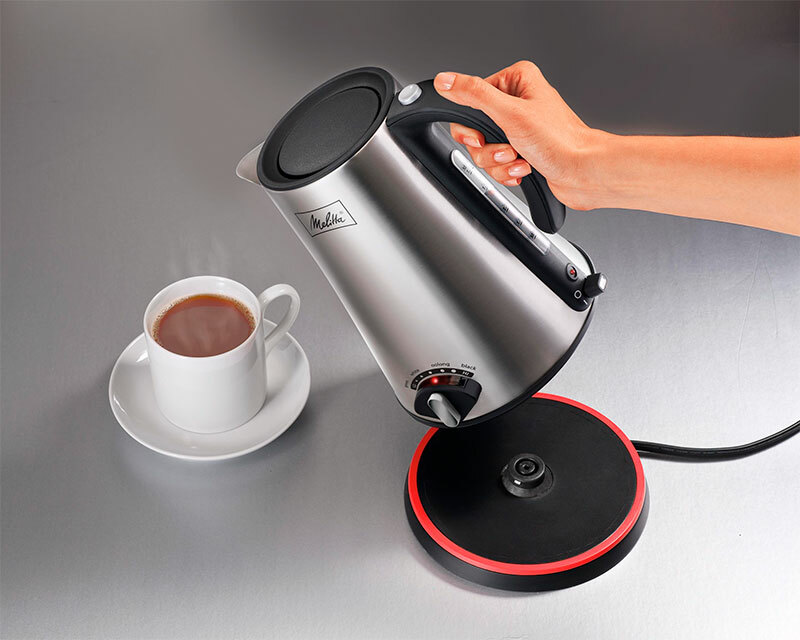
1. For those who are interested in cheap models for a summer residence or a study, a plastic teapot with an open spiral becomes a good purchase. The volume should be in the range of 1-1.7 liters or liter, if you use boiling water alone. Power also needs a minimum( about 350-500 watts), especially if you have weak wiring.
2. Multifunctional models with a thermoregulator that can heat water up to the "right" temperature necessary for green or herbal tea are suitable for true gourmets. Excellent, if the teapot turns out to be glass or ceramic, then the drink will not have a foreign taste. In addition to the main unit, you can buy an electric brewer or find a combined device.
3. If you are a perfectionist in everything and advocate for a healthy lifestyle, feel free to take an electric kettle from heat-resistant glass. Choose a model of small or medium volume from 1 to 1.7 liters - so it will be easier for you to lift it, and it is undesirable to boil one serving of water several times.
4. To modern technology not vybivalas from the vintage or ethnic kitchen interior, you can buy a painted ceramic teapot, ideally suited to the chosen style. Just look for a small unit up to 1.5-1.7 liters, otherwise it will be difficult to lift it. But the power here needs maximum, otherwise you will have to wait a long time until the water in the ceramic thermos boils.
5. If you have any problems with household appliances or you constantly drop something, it's better to buy a metal kettle at once. The maximum that can happen to him with careless handling - a small dent on the body. Ideal model for a garage or a room in a student hostel.
6. Progressive owners of the "smart home" need at least an advanced smart kettle that can be controlled remotely. Run the application on your phone and it will boil water on your command. A convenient solution, if you like a couple more minutes to soak up in bed in the morning or late return from work and want to immediately drink tea.
Cost of electric kettle

1. The simplest electric kettles with an open spiral and plastic casing cost from 200 to 2200 rubles.
2. Metal has a higher price threshold - their cost starts from 700 rubles.
3. The largest run-up of prices is observed in a motley family of electric kettles with a closed spiral:
- plastic models cost between 200-8500 rubles;
- metal start from 300 and reach up to 19 thousand;
- Ceramic disk teapots are sold for 900-6000 rubles;
- glass is on average more expensive - from 800 to 15 thousand rubles.
4. Models with a thermoregulator will cost no less than 1,5-2 thousand, well, and the ceiling will already determine the material of the case:
- limit for plastic is 7500 rubles;
- a combination of metal with glass can pull and at 12 thousand;
- ceramics will come out no more than 6000.
5. Teapots are all in the same price range from 3 to 12 thousand rubles. The only exception is the model in the plastic case - here the ceiling is 8000 rubles. Metal cheeses are even cheaper - they can be bought at prices ranging from 800 to 6500 rubles.
6. Ultra-modern smart kettles are made only of plastic and stainless steel. In the first case, they will cost from 1 to 38 thousand rubles., In the second case, the price may increase to 55 thousand.
